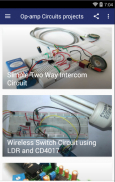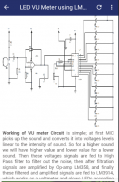








Op-amp Circuits projects

Mô tả của Op-amp Circuits projects
Op-amp Circuits projects
An operational amplifier (often op-amp or opamp) is a DC-coupled high-gain electronic voltage amplifier with a differential input and, usually, a single-ended output.[1] In this configuration, an op-amp produces an output potential (relative to circuit ground) that is typically hundreds of thousands of times larger than the potential difference between its input terminals. Operational amplifiers had their origins in analog computers, where they were used to perform mathematical operations in many linear, non-linear, and frequency-dependent circuits.
The popularity of the op-amp as a building block in analog circuits is due to its versatility. By using negative feedback, the characteristics of an op-amp circuit, its gain, input and output impedance, bandwidth etc. are determined by external components and have little dependence on temperature coefficients or manufacturing variations in the op-amp itself.
Op-amps are among the most widely used electronic devices today, being used in a vast array of consumer, industrial, and scientific devices. Many standard IC op-amps cost only a few cents in moderate production volume; however, some integrated or hybrid operational amplifiers with special performance specifications may cost over US$100 in small quantities.[2] Op-amps may be packaged as components or used as elements of more complex integrated circuits.
The op-amp is one type of differential amplifier. Other types of differential amplifier include the fully differential amplifier (similar to the op-amp, but with two outputs), the instrumentation amplifier (usually built from three op-amps), the isolation amplifier (similar to the instrumentation amplifier, but with tolerance to common-mode voltages that would destroy an ordinary op-amp), and negative-feedback amplifier (usually built from one or more op-amps and a resistive feedback network)
dự án Op-amp Mạch
Một bộ khuếch đại hoạt động (thường OpAmp hoặc opamp) là một độ lợi cao khuếch đại điện áp điện tử DC-coupled với một đầu vào khác biệt và, thông thường, một đầu ra single-end. [1] Trong cấu hình này, một op-amp tạo ra một tiềm năng đầu ra (so với mặt đất mạch) mà thường là hàng trăm hàng ngàn lần lớn hơn so với chênh lệch điện thế giữa thiết bị đầu cuối đầu vào của nó. khuếch đại thuật toán có nguồn gốc của họ trong các máy tính tương tự, nơi họ đã được sử dụng để thực hiện các phép toán trong nhiều tuyến tính, phi tuyến tính, và mạch tần số phụ thuộc.
Sự phổ biến của các op-amp là một khối xây dựng trong mạch analog là do tính linh hoạt của nó. Bằng việc sử dụng phản hồi tiêu cực, đặc điểm của một mạch op-amp, nó tăng, đầu vào và đầu ra trở kháng, băng thông vv được xác định bởi các thành phần bên ngoài và có rất ít phụ thuộc vào hệ số nhiệt độ hoặc các biến thể sản xuất trong op-amp chính nó.
Op-amps là một trong những thiết bị điện tử sử dụng rộng rãi nhất hiện nay, được sử dụng trong một loạt của người tiêu dùng, công nghiệp, và các thiết bị khoa học. Nhiều tiêu chuẩn vi mạch op-amps chi phí chỉ là một vài xu về khối lượng sản xuất vừa phải; Tuy nhiên, một số khuếch đại thuật toán tích hợp hoặc lai với kỹ thuật thi công đặc biệt có thể có giá hơn US $ 100 với số lượng nhỏ. [2] Op-amps có thể được đóng gói như các thành phần hoặc sử dụng như các yếu tố của mạch tích hợp phức tạp hơn.
Các op-amp là một loại khuếch đại vi sai. Các loại khuếch đại vi sai bao gồm bộ khuếch đại hoàn toàn khác biệt (tương tự như các op-amp, nhưng với hai kết quả đầu ra), bộ khuếch đại đo đạc (thường được xây dựng từ ba op-amps), bộ khuếch đại cách ly (tương tự như các bộ khuếch đại đo đạc, nhưng với sự khoan dung để điện áp chế độ chung rằng sẽ tiêu diệt một bình thường op-amp), và bộ khuếch đại âm phản hồi (thường được xây dựng từ một hoặc nhiều op-amps và một mạng lưới thông tin phản hồi điện trở)






















